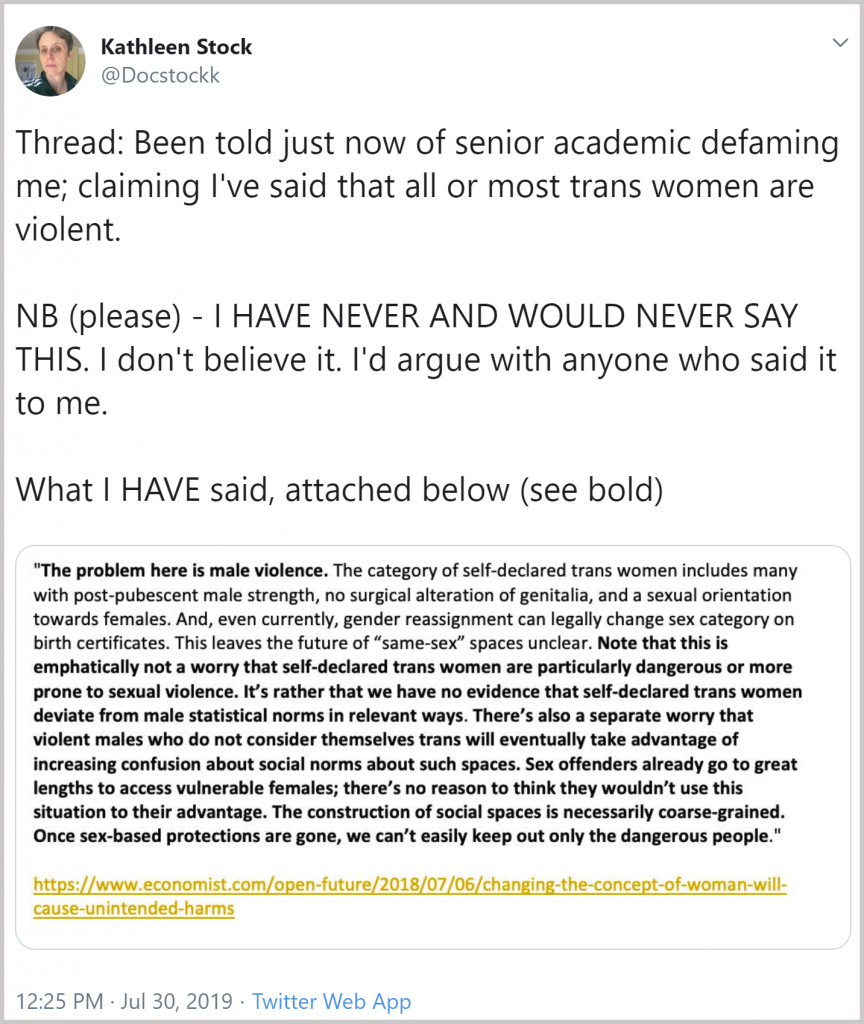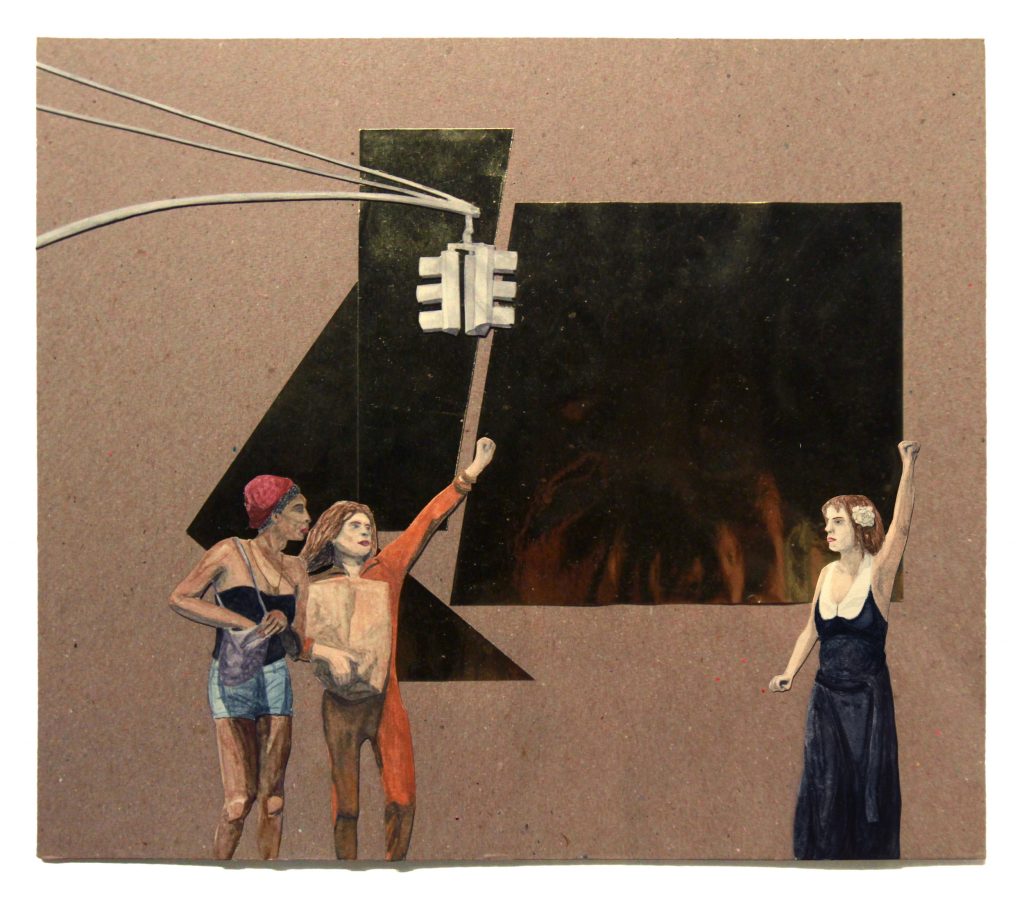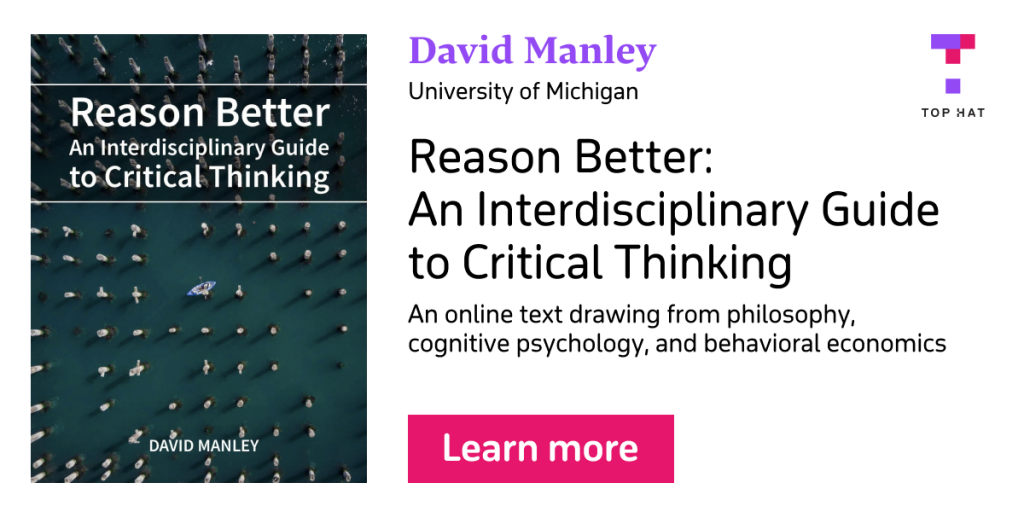Recognizing Gender Critical Feminism as Anti-Trans Activism (guest post)
“Our main point is that readers need to understand that the central problem is not how to uplift the message of ‘gender-critical’ voices, but how to understand them as activists, and how to manage content that is disrespectful, fear-mongering, and misleading, while avoiding harm to the scholarly community.”
The following is a guest post* by three philosophers who wish to remain anonymous (though their identity is known to me).
Recognizing Gender Critical Feminism as Anti-Trans Activism
by three anonymous philosophers
A recent letter published at Inside Higher Education argues that we should not censure writings by so-called “gender-critical” philosophers. We agree with the authors of the letter that philosophy should be “a discipline in which sensitive and controversial issues are investigated with patience, care and insight.” But “gender-critical” writings, which the letter defends, do not advance us toward this ideal.
The current crop of trans-exclusionary “gender-critical” philosophers is first and foremost an activist movement. Their writings and behavior are best understood as aimed at achieving their activist ends, such as preventing trans women from using facilities designated for women, or making it more difficult for trans women to be legally recognized as women. Like other activists, they will denigrate or vilify their opponents, make use of dogwhistles, appeal to people’s baser emotions to increase support for their cause, and ignore inconvenient facts. Far from being worthwhile contributions to a scholarly discussion, their writings rehash discredited claims from the 1980s (if not earlier), express demeaning and offensive ideas about trans people, and inhibit truly careful, critical, and thoughtful scholarly debate.
We don’t want to advance a view about the correct way to respond to these writings. We understand the worry that suppressing them could do more harm than good. Our main point is that readers need to understand that the central problem is not how to uplift the message of “gender-critical” voices, but how to understand them as activists, and how to manage content that is disrespectful, fear-mongering, and misleading, while avoiding harm to the scholarly community.
One problem is that it’s easy to miss the transphobia in trans-exclusionary writing, because it’s often cloaked in a veneer of politeness and ordinary language, while in fact functioning as a ‘dogwhistle’.
Dogwhistles are covert political tools used to stoke prejudicial attitudes. They consist of words and phrases that seem innocuous to the general public, but have a coded interpretation understood by a targeted subgroup. For example: ‘inner city’ and ‘law and order’ are often used as racist dogwhistles, allowing politicians to call for harsher criminal enforcement in black and brown neighborhoods without explicitly saying so. Similarly, terms like ‘male’, ‘men’, and ‘biological male’ are frequently used as transphobic dogwhistles when talking about trans persons.
In conversations about trans identity, dogwhistles appeal to hearers’ existing discomfort or disgust with trans and gender-nonconforming bodies, as well as deeply held, essentialist beliefs in ‘natural’ differences between men and women. They allow trans-hostile people to call for the exclusion and marginalization of trans and gender-nonconforming people without explicitly saying so.
Let’s look at some specific examples. Such examples abound; we’ve chosen a select few to keep this short. Since “gender-critical” conversation is primarily driven by posts on platforms such as Twitter and Medium, rather than peer-reviewed articles, our criticisms will also focus on Twitter and Medium posts.
Case 1: calling trans women ‘men’ in order to demean them
Of course, there’s nothing wrong with being a man, or with being a woman. But telling a woman she’s a man can be a misogynistic insult, and telling a man that he’s a woman can be a misogynistic way of belittling him. Someone who wants a mutually respectful conversation should avoid making such insulting suggestions.
Unfortunately, we often see “gender-critical” philosophers such as Sophie Allen, Holly Lawford-Smith, Mary Leng, and Kathleen Stock going out of their way to use the language of ‘men’ and ‘males’ to describe trans women, and the language of ‘women’ and ‘females’ to describe trans men. They’ve also refused to recognize non-binary persons: for example, Kathleen Stock referred to such persons as “so-called non-binary people” in an article for the online magazine Quillete.
Of course, there is a technical distinction in feminist philosophy between the sex categories male and female, and the gender categories woman and man. But on Twitter, where many of these conversations occur, there’s not much difference between calling a woman “a man” and calling her “male”; indeed, the authors in question often use these words interchangeably.
Consider this example, taken from a Medium post by Holly Lawford-Smith.
If trans people are really the worst off social group, as they claim to be, they’ll still have a good case for being a focus of feminist support and campaigning, on the view that being trans is something that seriously disadvantages some women (trans men).
Lawford-Smith superficially appears to be supporting the rights of trans people. But notice that, at the end of the sentence, she classifies trans men as women. This is denigrating and disrespectful to trans men in a way that undermines the appearance of feminist support: it’s a dogwhistle that, to those who are unfamiliar with the terms of the debate, will be coded as ordinary language.
Lawford-Smith, Stock, and others frequently call trans women “men” or “males”. In addition, it is possible to call a woman a “man” using images, rather than words. Because transition takes time, one can find old photographs of trans women that fit stereotypical assumptions about what men look like. Displaying such a photograph is a way to suggest that the subject is a man. In her Medium post “Hitching Glitterbeard Carts to Transsexual Wagons”, Holly Lawford-Smith includes a photo of trans woman Danielle Muscato, taken before (or early in) her transition to female, that encourages the reader to think of her as male. [Note: After the publication of this post, it was brought to our attention that this photo is approved for use on Danielle Muscato’s website. However, in the context of Lawford-Smith’s post, it conveys skepticism about Muscato’s identity as a woman.]
Case 2: sexualizing and objectifying trans people
It’s disrespectful to publicly speculate about your colleagues’ genitals, about whether you wish to have sex with them, or about who else wishes to have sex with them. This kind of speculation creates a hostile environment, and does not conduce to legitimate academic debate. And yet, we often see “gender critical” philosophers scrutinizing trans people’s bodies and sexualities in inappropriate ways.
Consider Kathleen Stock’s recent lecture for the Aristotelian Society, which discusses whether lesbians would or should want to have sex with trans women. Stock objects to “two conclusions” typically drawn by her opponents.
The first conclusion effectively says that a lesbian, understood as subject with a ‘female gender’ who is disposed to desire others with a ‘female gender’, might, as such, straightforwardly and repeatedly experience attraction to trans women as part of the normal terms of their own orientation, even under ideal conditions (see for instance, Chuck Tate 2012). The second is that any trans woman who is exclusively attracted to others with a ‘female gender’ counts as a lesbian (Chuck Tate 2012; Sharpe 2019). In other words, biologically male people can be the objects of genuine lesbian desire, and even can be lesbians themselves.
There are many reasons to be wary of such claims… But the main point to take away from present discussion is that such claims look confused.
Stock appears to be making the following two claims:
- Trans women are not objects of genuine lesbian desire (although lesbians might under “abnormal” or “non-ideal” circumstances experience sexual desire for trans women).
- Trans women cannot be lesbians.
There’s no reason for academic philosophers to publicly debate the sexual desirability of trans people in this way. This is something we can all sort out in our own private lives.
Stock also speculates about trans women’s genitalia, as illustrated by this Medium post:
Furthermore, many self-declared trans women retain male genitalia. Some trans activists have it that female lesbians are “transphobic” for ruling out sexual attraction for those with male genitalia. The upshot of this is likely to involve confusion and shame for some emerging young lesbians, socially pressured into considering sleeping with males to whom they are fundamentally unattracted, as determined by their basic sexual orientation.
Of course, it is wrong for anyone to pressure another person into sex, but trans women’s genitalia and sexualities are utterly irrelevant to this point. It’s just as wrong for a cis women to pressure someone into sex, as it is for a trans woman to pressure someone into sex. This remark is an example of the gratuitous, irrelevant, and offensive way in which trans people’s genitalia are often brought into discussions. It’s also an example of empirically baseless, fear-mongering speculation that stokes fear and hatred toward trans people.
Case 3: making false empirical claims that threaten trans people’s access to public goods
Trans people’s access to public goods, such as bathroom access, identification documents, and health care, is under threat in many countries. “Gender-critical” philosophers often use false empirical claims to advocate for legal and social policies that would further endanger access to these goods. Making arguments for policies that threaten the health and well-being of trans people based on false empirical claims is bad science, bad philosophy, and bad citizenship.
Consider this Medium post, where Kathleen Stock argues against a reform to UK law that would allow trans people to change the gender markers on their documents by self-identification, rather than requiring doctors’ notes. Stock claims that if we allow this legal change, predatory men will break into women-only facilities to harass women.
It seems clear that woman-only spaces such as changing rooms, hostels, and prisons should be organised according to sex category, not self-assigned gender. Transwomen are biologically male. Studies show that most retain male genitalia. Many have a sexual orientation towards females. If we think there are good reasons to retain same-sex spaces generally, in terms of protecting females from a small number of malfeasant males, these reasons don’t cease to operate when males self-identify as women. Either we keep same-sex spaces, or the result is effectively mixed-sex spaces, to the detriment of females.
Stock’s conjecture is not supported by any of the available evidence. Portraying trans women as sexual predators is both false and demeaning. And in jurisdictions that allow for ID change based on self-identification, such as California and Ireland, there is no evidence that cis men are thereby inspired to break into women’s facilities.
(Notice that in Stock’s Medium essay, several things are going on at once. Stock is undermining trans people’s access to single-sex facilities like changing rooms as well as their access to legal documents. She is also insinuating that trans women are men, and objectifying trans women’s bodies and sexualities.)
In addition to using dogwhistles and making false empirical claims, gender critical feminists also frequently gaslight those who call them out for making these false claims:

In the original text from The Economist, Stock makes the following claims: (1) Male violence is a problem. (2) The category ‘trans women’ includes people with “male strength” and “genitalia” who are attracted to “females”. (Authors’ note: “female” is explicitly used here to exclude trans women, and the term “male strength” and “genitalia” is used to describe trans women, invoking speculations about trans women’s bodies that heighten transphobic attitudes of fear and disgust.) (3) We have reason to suspect that trans women will enact “male violence” with the same frequency as cisgender men.
As mentioned above, Stock’s claim (3) is not supported, and in fact is undermined by the existing empirical evidence. What’s more, though, it should be clear to any reader that, with this combination of claims, Stock is insinuating that trans women are dangerous to cisgender women. But she then gaslights those who call her out for this false claim by invoking the surface level meaning of the text, rather than the thinly veiled coded meaning, protesting that she “never said” this.
Conclusion
The outcry about gender-critical philosophers stems from how they are championing arguments in ways that are offensive and demeaning, by stereotyping, pathologizing, and sexualizing trans people. Their writings are inflammatory, derogatory, and uninformed, and create unnecessary discord and distraction from the issues that matter. There are substantive and difficult questions about what to do when faced with this rhetoric. However, the first step toward an adequate response is to recognize it for what it is.
art: Tuesday Smillie, “S.T.A.R.”
Comments are closed here, but readers are welcome to discuss this post on Twitter (#DNrecognizing) as well as on the Facebook update for this post.



